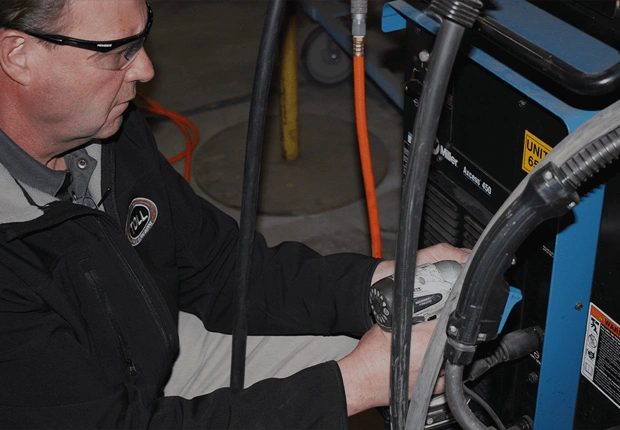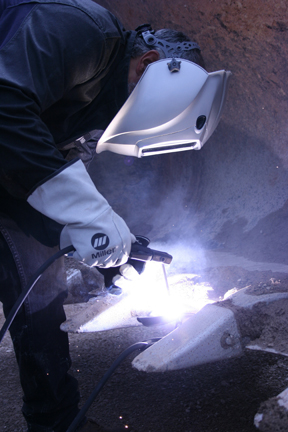Common Welding Repair Issues and How to Address Them Properly
Welding fixings commonly come across a variety of issues that can threaten the integrity of the end product. Usual troubles consist of inadequate infiltration, porosity, and imbalance, to name a few. Each defect offers unique difficulties that call for specific techniques for resolution. Comprehending these problems is crucial for welders intending to boost their results and skills. This discussion will discover these usual welding repair service issues and efficient techniques to resolve them.
Poor Infiltration
Poor infiltration occurs when the weld metal fails to completely fuse with the base product, causing weak joints and prospective structural failings. This problem usually comes from inadequate heat input, inaccurate electrode angle, or inappropriate welding rate. Welders might encounter insufficient penetration because of a mistake of the essential criteria for a particular material thickness or kind. Additionally, contamination on the base product's surface can impede efficient bonding, aggravating the trouble. To resolve poor penetration, welders should assure suitable settings on their tools and preserve a clean work surface area. Normal examination of welds is recommended to determine any deficiencies early, enabling prompt corrections and the prevention of endangered architectural stability in welded assemblies.
Porosity
Porosity is an usual issue in welded joints that manifests as little gas bubbles entraped within the weld steel. This problem can endanger the stability of the weld, resulting in minimized stamina and potential failure under tension. Welding. Porosity commonly develops from contamination, dampness, or improper welding techniques, which allow gases to get away into the liquified weld pool. To attend to porosity, welders should ensure correct surface prep work, keep a clean working setting, and utilize appropriate welding specifications. Furthermore, picking the appropriate filler product and protecting gas can reduce gas entrapment. Normal inspection and screening of welds can assist recognize porosity early, guaranteeing timely rehabilitative actions are taken, therefore preserving the high quality and integrity of the bonded structure
Imbalance
Imbalance in welding can occur from different aspects, including incorrect setup and thermal expansion. Comprehending the root triggers is essential for efficient resolution. Numerous modification strategies are readily available to realign components and guarantee structural honesty.
Reasons of Misalignment
Welding imbalance often originates from a selection of underlying problems that can endanger structural integrity. One primary cause is inappropriate fit-up of elements prior to welding, which can lead to spaces and uneven surface areas. Variations in thermal development throughout the welding procedure can likewise lead to distortion, especially if the products being signed up with have various coefficients of growth. Additionally, insufficient securing and fixturing may fall short to hold elements securely in location, causing movement during welding. Poorly conserved equipment, including welding makers and devices, might introduce incongruities in the weld grain, additional adding to imbalance. Driver mistake, stemming from insufficient training or experience, can likewise play a significant function in producing misaligned welds.

Adjustment Strategies Offered
Resolving misalignment properly calls for a mix of restorative strategies customized to the certain concerns handy. One usual technique is the use of fixtures or jigs to hold parts in the right position during welding, making certain constant positioning. In addition, preheating the products can assist minimize distortion and improve fit-up. For considerable imbalance, mechanical realignment techniques, such as using hydraulic jacks or clamps, can be employed to correct the position before welding. Post-weld warmth treatment may additionally be necessary to eliminate stresses triggered by imbalance. Mindful inspection and adjustment during the arrangement stage can avoid misalignment concerns from coming to be significant troubles, promoting a smoother welding process and boosting total structural stability.
Distortion
Distortion is an usual difficulty in welding that can develop from numerous elements, including unequal cooling and heating. Understanding the reasons of distortion is vital for applying reliable avoidance strategies. Resolving this concern not just enhances structural honesty but also boosts the total top quality of the weld.
Root causes of Distortion
When subjected to the extreme warm of welding, products often go through modifications that can result in distortion. This sensation largely develops from thermal expansion and tightening during the welding process. As the weld location heats up, the product broadens; upon air conditioning, it acquires, which can create internal stress and anxieties. Furthermore, unequal home heating across a workpiece can exacerbate these stress and anxieties, causing bending or bending. The sort of product additionally plays a considerable role; metals with differing thermal conductivity and coefficients of expansion may respond in different ways, causing unpredictable distortions. In addition, poor joint layout and inadequate fixturing can contribute to misalignment during welding, increasing the likelihood of distortion. Understanding these causes is vital for reliable welding fixing and prevention techniques.
Prevention Techniques
Reliable avoidance strategies for distortion throughout welding emphasis on managing warm input and making certain correct joint layout. Keeping a constant warm input aids to lessen thermal growth and contraction, which can bring about distortion. Utilizing methods such as pre-heating the work surface can likewise minimize the temperature level gradient, promoting consistent heating. In addition, picking proper joint layouts, such as T-joints or lap joints, can boost stability and lower stress concentrations. Carrying out proper fixturing to safeguard the work surfaces in location even more aids in maintaining placement during the welding procedure. Staggered welding series can disperse heat much more equally, protecting against local distortion. By using these strategies, welders can considerably decrease the likelihood of distortion and enhance the total top quality of their welds.
Splitting
Fracturing is a typical issue experienced in welding repairs, often arising from numerous variables such as improper cooling rates, product choice, or insufficient joint preparation. The event of cracks can spot welder for sale considerably jeopardize the integrity of the weld, bring about prospective failures during procedure. To resolve this problem, welders must first evaluate the source, making certain that products work and suitably chosen for the details application. Furthermore, regulating the cooling price during the welding procedure is necessary; quick air conditioning can generate stress and anxiety and cause fracturing. Proper joint layout and preparation likewise add to decreasing the threat. Implementing these approaches can improve weld top quality and toughness, inevitably reducing the probability of breaking in ended up weldments.

Incomplete Blend
A considerable concern in welding repairs is insufficient combination, which takes place when the weld metal does not properly bond with the base material or previous weld passes - Welding. This flaw can bring about weaknesses in the joint, possibly endangering look at this web-site the integrity of the bonded framework. Factors contributing to incomplete blend consist of insufficient heat input, incorrect welding technique, and contamination of the surface areas being signed up with. To address this issue effectively, welders should ensure proper pre-weld cleansing and surface area preparation, along with readjust their welding parameters to accomplish adequate infiltration and combination. Routine inspection during the welding procedure can also help recognize insufficient combination early, permitting prompt rehabilitative steps to boost the overall high quality of the weld
Overheating
While welding repairs can improve architectural honesty, overheating provides a significant obstacle that can result in product degradation. Too much heat throughout welding can alter the mechanical properties of steels, causing decreased stamina, increased brittleness, and bending. This sensation is particularly essential in high-stress applications where structural integrity is extremely important. Identifying getting too hot can involve aesthetic examinations for discoloration or distortion, in addition to checking temperature level throughout the welding procedure. To minimize the threats connected with overheating, welders need to utilize ideal methods, such as controlling heat input, readjusting traveling rate, and using suitable filler products. Additionally, implementing pre- and post-weld warmth therapies can aid bring back material buildings and enhance the general high quality of the repair, guaranteeing long-lasting efficiency and safety and security.
Frequently Asked Inquiries
What Are the Usual Signs of a Welding Flaw?

How Can I Evaluate My Welds for Quality?
To test welds for quality, one can make use of visual examinations, ultrasonic testing, and radiographic approaches. Each method assures structural navigate here integrity, identifies issues, and validates adherence to specified standards, ultimately boosting the dependability of the bonded joints.
What Security Precautions Should I Take While Welding?
When welding, one should prioritize safety by using proper personal protective devices, ensuring appropriate ventilation, securing flammable products away, preserving a tidy work area, and understanding surroundings to prevent mishaps and injuries.
Can I Fix a Weld Without Redoing the Entire Joint?
Fixing a weld without remodeling the whole joint is possible, relying on the damages (Fabrication). Strategies such as grinding, adding filler product, or utilizing a welding process can properly resolve specific defects while maintaining the bordering structure
What Tools Are Crucial for Effective Welding Fixes?
Vital tools for reliable welding fixings consist of a welding equipment, wire brush, mill, protective equipment, clamps, and filler products. Each device plays a vital role in guaranteeing high quality and safety and security throughout the repair process. Porosity usually develops from contamination, wetness, or improper welding methods, which allow gases to leave into the liquified weld swimming pool. Improperly conserved devices, including welding machines and tools, might present inconsistencies in the weld grain, more contributing to misalignment. When subjected to the intense warmth of welding, products often undertake modifications that can lead to distortion. Cracking is a common concern encountered in welding repair work, commonly resulting from different variables such as inappropriate cooling prices, material choice, or inadequate joint prep work. A significant concern in welding repair work is incomplete fusion, which takes place when the weld steel does not properly bond with the base material or previous weld passes.